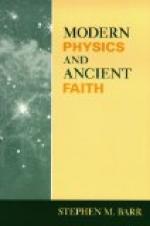PREFACE
The Editor of the Theosophical Forum in April, 1901, noted the death of Mr. Thomas E. Willson in the previous month in an article which we reproduce for the reason that we believe many readers who have been following the chapters of “Ancient and Modern Physics” during the last year will like to know something of the author. In these paragraphs is said all that need be said of one of our most devoted and understanding Theosophists.
In March, 1901, The Theosophical Forum lost one of its most willing and unfailing contributors. Mr. T.E. Willson died suddenly, and the news of his death reached me when I actually was in the act of preparing the concluding chapter of his “Ancient and Modern Physics” for the April number.
Like the swan, who sings his one song, when feeling that death is near, Mr. Willson gave his brother co-workers in the Theosophical field all that was best, ripest and most suggestive in his thought in the series of articles the last of which is to come out in the same number with this.
The last time I had a long talk with T.E. Willson, he said”
“For twenty years and more I was without a hearing, yet my interest and my faith in what I had to say never flagged, the eagerness of my love for my subject never diminished.”
This needs no comment. The quiet and sustained resistance to indifference and lack of appreciation, is truly the steady ballast which has prevented our Theosophical ship from aimless and fatal wanderings, though of inclement weather and adverse winds we had plenty.
For many long years Mr. Willson was the librarian of the New York “World.” In the afternoons he was too busy to see outsiders, but, beginning with five o’clock in the afternoon until he went home somewhere in the neighbourhood of midnight, he always was glad to see his friends. He had a tiny little room of his own, very near the top of the tremendous building, his one window looking far above the roofs of the tallest houses in the district. There he sat at his desk, generally in his shirt sleeves, if the weather was at all warm, always busy with some matter already printed, or going to be, a quiet, yet impressive and dignified figure.
The elevated isolation, both figuratively and literally speaking, in which T.E. Willson lived and worked, in the midst of the most crowded thoroughfares of New York, always made me think of Professor Teufelsdrockh on the attic floor of “the highest house in the Wahngasse.” The two had more than one point of resemblance. They shared the loftiness of their point of view, their sympathetic understanding of other folks, their loneliness, and, above all, their patient, even humorous resignation to the fact of this loneliness.
Yet in his appearance Mr. Willson was not like the great Weissnichtwo philosopher. In fact, in the cast of his features and in his ways, Mr. Willson never looked to me like a white man. In British India I have known Brahmans of the better type exactly with the same sallow complexion, same quick and observant brown eye, same portly figure and same wide-awakeness and agility of manner.




